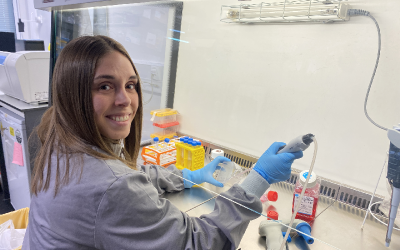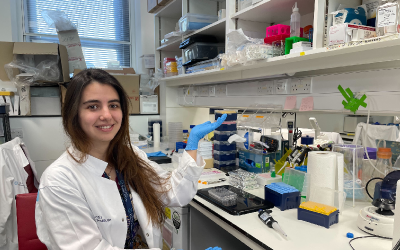Dr Tim Bartels, group leader at the UK Dementia Research Institute at UCL, tells us about his lab’s highly collaborative approach to research
Dr Tim Bartels is group leader at the UK Dementia Research Institute at UCL. Based at the Cruciform building, the lab is made up of nine people including three PhD students, three research assistants and two research fellows.

Tim Bartels' lab team
My lab is part of the UK Dementia Research Institute. Our research is focused on understanding the molecular basis of neurodegenerative diseases. We investigate “synucleinopathies” - these encompass Parkinson’s disease, multiple system atrophy and the Lewy body dementias.
“In my experience, basic research that translates into clinically meaningful treatments and diagnostics is still low rare, so our approach is to first look into human tissue, and then go deeper and deeper into modelling to understand and try to rectify what we have observed in the patients.
The main molecule responsible for causing mayhem seems to be the protein “alpha-synuclein”. Alpha synuclein is a small neuronal protein that gets broadly produced throughout the whole brain during the entirety of our lives. It seems to dysfunction in a smaller percentage of the elderly population in a brain region-specific manner, giving rise to the clinically-distinct synucleinopathies.
Even after over 25 years of studying its involvement in disease, what governs synuclein’s switch from physiological to pathological, and what dictates the local resilience or susceptibility throughout the brain to its dysfunction, is still an enigma.
This is where our lab comes in.
In my experience, basic research that translates into clinically meaningful treatments and diagnostics is still low and so our approach is to first look into human tissue (at the moment in close collaboration with Zane Jaunmuktane at the world-leading Queen Square Brain Bank), and then go deeper and deeper into modelling to understand and try to rectify what we have observed in the patients.
As a question-driven lab, we use a variety of cutting-edge technologies depending on the mechanistic scope that we are studying. So, if we have a question that aims at understanding tissue region specificity, the interplay between the peripheral and the central nervous system or the interaction between different cell types (as currently done in collaboration with Soyon Hong at the DRI), animal models are invaluable to elucidate disease-relevant mechanisms.
We then study either human stem cell-derived neuronal models or use advanced methods of structural biology on isolated molecules to gain a fine-grained understanding of how things work within a cell or between two molecules.
We are a globally-oriented lab, since the wide variety of expertise needed for these holistic studies of pathomechanism needs a diverse cast of specialists, which enables us to take part in large, multi-lab-spanning studies.
Our many collaborators are from the USA and mainland Europe and, of course, from the UK and within the DRI.
Given our expertise in analysing human tissue and replicating disease-relevant molecules in vitro, we also have strong collaborators in the pharma and biotech industries. We provide them with our novel experimental assays, disease expertise or simply calibrators for their own drug development efforts. At the same time, we are trying to foster a stronger collaboration with our clinical colleagues to translate our work into a meaningful benefit for the patient.
As a result, we are currently working together with Dr Rimona Weil at the National Hospital of Neurology and Neurosurgery at Queen Square, with funding by Eisai pharmaceuticals to deliver a blood biomarker potentially catching the beginning of Parkinson’s disease before it becomes clinically visible.
“The prospect of having close contact with...and more integration with the clinic and my other colleagues at UCL is something that truly excites me [about Grays Inn Road] in its potential to develop impactful new biological insights and research tools as well as diagnostics and therapeutics.
We are also working on making experimental spinal fluid biomarkers robust enough for NHS-wide application, supporting the effort of Melanie Hart at University College London Hospitals and Sonia Gandhi at the Crick Institute, or developing a novel tracer usable in radiology with colleagues at Harvard Medical School.
For me personally, it is especially satisfying see these efforts coming full-circle. This recently happened when we conducted a target-engagement study for a biotech company. The company are testing a potential Parkinson’s disease drug on patients, based on research conducted in my lab several years ago.
This close contact with different approaches and expertise is also what I appreciate about the planned Grays Inn Road building. The prospect of having close contact with, not only the other members of the DRI, but also more integration with the clinic and my other colleagues at UCL is something that truly excites me in its potential to develop impactful new biological insights and research tools as well as diagnostics and therapeutics.
 Close
Close



